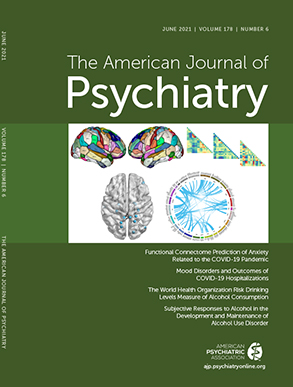I write this in terrible times. Across the world, a pandemic rages nearly unchecked when simple behavioral changes could save many lives. Psychiatric disorders and their sequalae have sharply increased. The role of science, logic, data, and expertise have been pushed to the curb in favor of those who shout loudest.
In this context—especially in this context—it is a delight and a comfort to read and comment on Prof. Kendler’s latest scholarly work, in this issue of the
Journal (
1), on what observant early European and American psychiatrists made of the tendency of severe mental illnesses to run in families: delight from the craft, care, and scholarship that comprise (and typify) Kendler’s contributions, and comfort from the echo of clinical inferences drawn by our predecessors centuries ago in the empirical data we have today. After defining a few terms, one can imagine an interesting conversation with these clinicians. (A further comfort is the reminder that human history has always been tough—war, pandemic, genocide, enslavement, persecution, famine, threat, and uncertainty; they got through it, and so will we.)
Kendler has long been devoted to the historical and philosophical basis of psychiatry and, particularly, genetic approaches. In this new work, he identifies and reviews 48 texts from the late Holocene. It is always tricky to place boundaries on continua, but the choice of starting with the work of Cullen (1780) and continuing through that of Rüdin and Rosanoff (just before World War I) constitutes a defensible set of bookends. Notably, these works were blind to fundamental genetic facts (DNA, chromosomes, principles of inheritance) as well as to all the careful empiricism of psychiatric epidemiology, genetic epidemiology, and genetics that inform us today.
And yet these observant and thoughtful clinicians from 110-plus years ago mostly got it right. Kendler’s core conclusions from his review parallel modern findings. It seems reasonable to assume that “insanity” translates to modern diagnostic entities—idiopathic syndromes with prominent, persistent, and pervasive psychotic symptoms like schizophrenia, schizoaffective disorder, or a mood disorder with psychotic features—and assuming that there are relatively small proportions of people with some other psychiatric disorder confusable with “insanity” (e.g., autism, obsessive-compulsive disorder, posttraumatic stress disorder, anorexia nervosa, severe alcoholism) or a general medical cause (pellagra, neurosyphilis, etc.). There are precise parallels in the top-level conclusions: family history is a strong risk factor for psychotic disorders; inheritance is probabilistic, not deterministic; inheritance affects risk for a class of psychiatric disorders rather than one type; and risk blends into normal personality and behavior.
All of these features are supported in the current literature. Crucially, the findings noted by Kendler have been extended with direct measurements of DNA variation at genome scale in large samples from across the world. DNA findings are augmented with information from functional studies of the human brain (increasingly at the single-cell level). As touchstones for the interested reader, various papers may be found that describe current knowledge of the genetic architectures of psychiatric disorders (
2), the state-of-the-science for schizophrenia (the most advanced form of insanity) (
3–
5) and autism (
6), topical reviews of all major disorders (
7), the overlap of genetic risk between different psychiatric disorders (
8), connections to brain cell types (
9,
10), and the clinical implications (
11). One of the empirical triumphs of the past decade is the vast increase in secure empirical knowledge: we are getting at the ground truths for psychiatric disorders, a foundation that we have never had before.
All papers have limitations. As an active researcher in psychiatric genomics, did Kendler project his “presentism” onto these texts? Do these texts reflect fewer unique perspectives—was there a great professor or two whose opinions are common to all accounts? These seem unlikely, as so many different authors expressed similar ideas over time (130 years), geography (from the United States to Austria), and competing intellectual traditions. The detail provided in the article’s tables serve to diminish these concerns. To expand out from European thought, my hope is that someone reading this will help us understand thinking about genetics and insanity from non-European traditions (e.g., the great physicians from Islam, China, and India).
As noted in Kendler’s introduction, many date “real genetics” to Mendel, Galton, Fisher, and Pearson around a century ago (for that matter, some think that papers without a PDF or absent from their Twitter feed are not worth reading). This careful review demonstrates that core genetic concepts were widely appreciated long before any of this. For that matter, humans have been doing practical genetics for millennia, such as when we (repeatedly) domesticated wolves and horses and improved maize and grain via thoughtful observation and practical experimentation. In fact, it is more pervasive, deeper, and far older than any of this: our genomes and risks for severe psychiatric disorders are still deeply affected by hundreds of millions of years of mammalian evolution (
12,
13).

